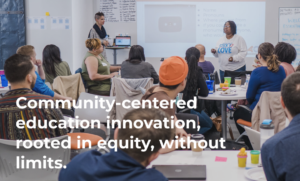Leaders, Learners and Designers all Listen First

As part of our team’s commitment to learning together, we recently discussed Brene’ Brown’s TED talk, The Power of Vulnerability. While I had heard this excellent talk before, this time I was especially drawn to reflect upon the practices and conditions must exist to promote vulnerability and what they mean for relationships, learning, and design processes.
Intuitively, we sense that practices such as listening and empathizing build a culture conducive to good relationships – as it turns out, these same practices also promote great learning and great design as well.
According to Brown, our ability to be authentic, be vulnerable, and connect with others (important for learning) really comes down to one thing: feeling a sense of worthiness and belonging. Through her research, Brown found one variable that separated those who have it and those who don’t: belief. In other words,
To feel worthy of love and belonging (and therefore able to connect with others) people have to believe they are worthy of love and belonging.
Knowing this, how can we help students, colleagues, and others believe they are worthy and simultaneously promote good work and learning?
Reflecting on that question, I realized an answer was staring me right in the face – literally – with this piece of framed Harold Balazs artwork and embedded quote hanging right above my desk. Our administrative team received the artwork as a gift from Superintendent Bill Mester, currently of Snohomish SD (WA). Even more importantly, our Mead SD team received countless hours of modeling of these concepts by Bill and (then) Associate Superintendent Joan Kingrey. These words offer insight on just how to instill this sense of worthiness and foster great learning.
Leaders listen deeply and fully to others
~ this provides for healing
Leaders reflect for others their beauty and talents
~ this will serve as a catalyst for growth
Leaders act with profound respect for the dignity and worth of all people
~ this will provide the moral foundation for your work.
For each of those key processes – listening, reflecting, and respecting – here are some connections for relationships, learning and design.
Listen. We’ve long heard listening is key to relationship-building that it can catalyze growth. Further, it is typically the first stage of any good learning or design process. As a learning design firm, our team at Getting Smart recently compared several design processes. The first stage of the process outlined by Stanford University’s School of Education (SUSE) is indeed called “listening.” This builds off of Stanford’s d.school’s design process, which refers to the first stage as “empathize. Springpoint Schools calls their first step “engagement.” Even in “non-education specific design, a Universal Principles of Design publication start with “understanding requirements. Relationships, learning, and design processes all start with listening.
Reflect. While we often think of reflection as an inner process, it also involves externally reflecting back to others their beauty and talents, Again, in the learning and design process, a “next step” after listening is often checking for understanding. Reflecting back to others what we observe is key to learning, design, and relational processes and connects directly to a broader definition of empathy. Such an approach is being encouraged by Ashoka Changemakers in their initiative called Activating Empathy for classrooms. Start Empathy offers a variety of courses, include one called Validating Every Voice, underscores the “reflect back” point. The formative assessment process offers a perfect opportunity for reflecting back to students. A typical design process moves from a something that involves listening to a reflection, for example a process called “point of view” from SUSE.
Respect. This third piece shows a direct connection to Brown’s work as how we treat others is an indication of how much we respect them. Much of this connection between believing and feeling is intuitive and can be fostered with an environment of respect in schools and beyond:
In order for kids to feel smart, they have to believe they are smart.
In order for kids to feel like they can contribute, they have to believe they can contribute
In order for teachers to feel effective with kids, they have to believe they can be effective
According to Mike Dunn, now Superintendent of NEWESD, and former principal in Mead, “This is one of the most impactful pieces on leadership ever; a wise reminder that leadership at its core and its best is about serving and supporting others, helping them become all they are and can be.”
Indeed, showing “profound respect for the dignity and worth of all people” is the foundation upon which strong relationships and strong learning are built. That is the sort of commitment needed to make the goal of education as a public good a reality.
In our schools and beyond, we want to foster a place where people can live wholeheartedly. As Brown says, “Wholehearted people live form this deep sense of worthiness and are open to connection with others.”
For more, check out:






John Sutherland
This is an excellent piece because it emphasizes listening as the key ingredient of mentorship and leadership. The reflection which comes after listening means that a person integrates what they have heard from somebody else into understanding. Respect is the end result of what happens when we have shared the process of growth with a team member.
Kelly Shea
Nicely done, Mary. You have provided a wonderful and meaninful interpretation of the very words I have hanging on my wall.